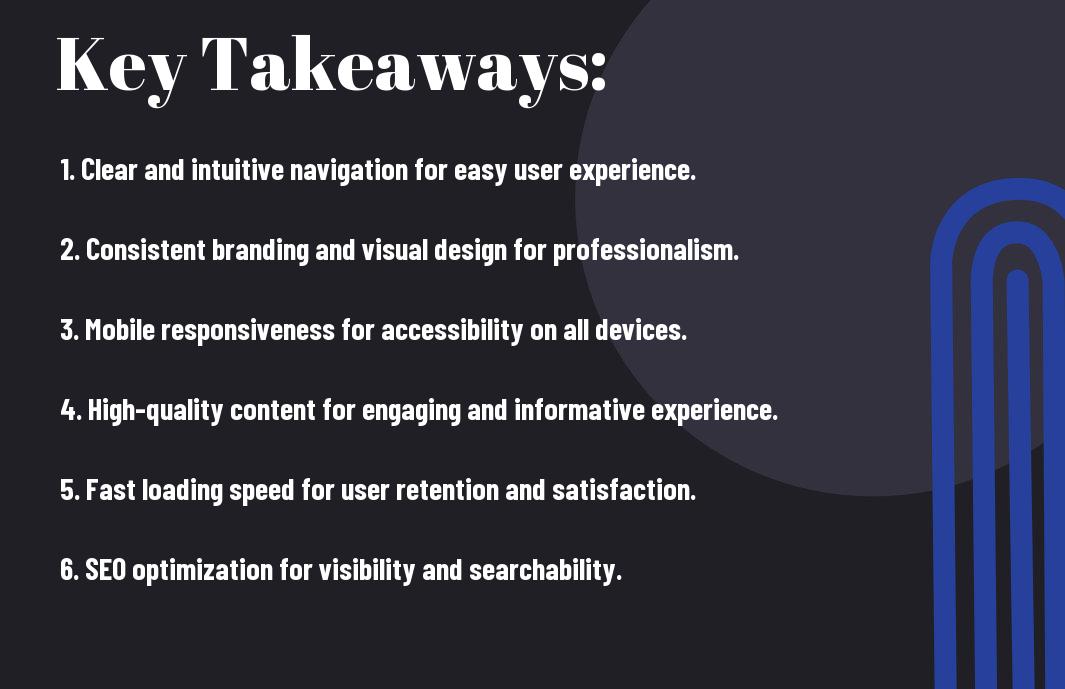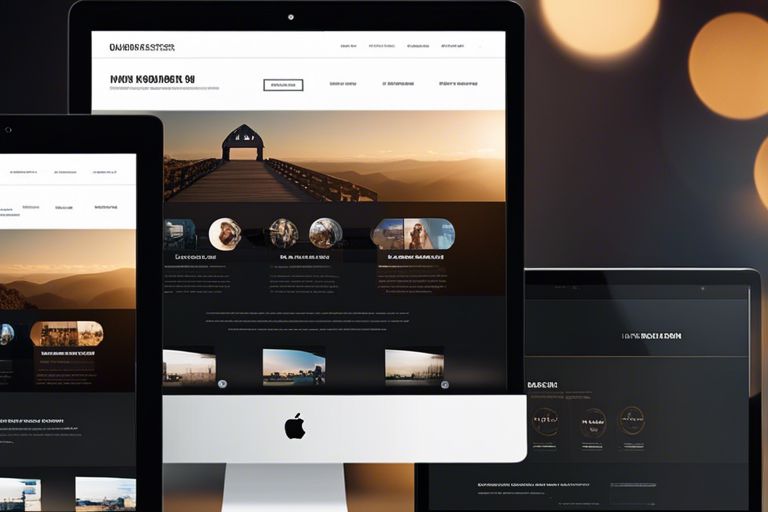Embarking on the journey of creating a successful business website requires more than just a basic understanding of web design. To truly make an impact and stand out from the competition, you need to consider various factors that influence the effectiveness and appeal of your website. From the user experience to search engine optimization, there are key elements that must be incorporated to ensure that your website achieves its intended goals. In this blog post, we will discuss the critical components involved in designing a great business website that not only attracts visitors but also converts them into loyal customers. So, let’s dive in and discover what it takes to create a business website that truly shines in the digital landscape.
Key Takeaways:
- Clear and intuitive navigation: A great business website should have easy-to-use navigation that allows users to find the information they need quickly and easily.
- Mobile-responsive design: With the high percentage of users accessing websites on their mobile devices, a great business website needs to be optimized for mobile viewing.
- Quality content: Providing valuable and engaging content is crucial for a great business website. This includes informative articles, captivating images, and helpful resources.
- Strong branding elements: A great business website should showcase the company’s brand through consistent use of colors, logo, and messaging to create a cohesive and memorable experience for visitors.
- Effective call-to-action: It’s important to have clear and compelling calls-to-action throughout the website to guide visitors toward the desired actions, such as making a purchase or contacting the business.

Understanding Your Audience
The first step in designing a business website is understanding your audience. You need to know who you are targeting and what their needs and preferences are. This will guide your design decisions and ensure that your website effectively communicates with your intended audience. For more information on how to make a good website in 2023, check out this comprehensive guide: How to Make a Good Website in 2023 – 12 Expert Driven Tips.
User Experience (UX) Fundamentals
When designing your business website, it’s crucial to prioritize user experience (UX) to ensure that visitors have a seamless and enjoyable interaction with your site. This includes having a clear navigation system, fast loading times, and visually appealing design. You want to make sure that every visitor to your site has a positive and memorable experience that reflects well on your brand.
Creating User Personas and Targeting
Another important aspect of understanding your audience is creating user personas and targeting specific groups of potential customers. By defining these personas, you can tailor your website content, design, and messaging to better resonate with their needs and preferences. This targeted approach will help you connect with your audience on a deeper level and increase the likelihood of them converting into customers.
Aesthetic and Functional Design
Keep in mind that the aesthetic and functional design of your website plays a crucial role in the overall user experience. Your website has to look good, but it also needs to function smoothly and efficiently. Striking the right balance between aesthetics and functionality is the key to designing a great business website.
Visual Branding and Consistency
When it comes to visual branding and consistency, your website should reflect your brand’s identity and values. Consistency in color schemes, typography, and imagery across all pages of your website is essential to create a strong and memorable brand image. This will help your visitors recognize your brand and feel connected to it, which ultimately builds trust and credibility.
Navigational Structure and Accessibility
Creating a clear and intuitive navigational structure on your website is crucial for ensuring that your visitors can easily find what they’re looking for. A well-organized navigation menu and logical page hierarchy make it easier for visitors to explore your website and access the information they need. Additionally, ensuring that your website is accessible to all users, including those with disabilities, is not only a legal requirement but also a moral obligation. Implementing accessibility features such as alt text for images, keyboard navigation, and readable font sizes will enhance the user experience for all visitors.
Content and SEO Strategies
Now that you have a visually appealing and user-friendly website, it’s time to focus on the content and SEO strategies to drive traffic and improve your search engine rankings. For more in-depth tips on website design, you can also check out Website Design Tips for Small Businesses.
Crafting High-Quality Content
When it comes to creating content for your business website, quality is key. Your content should not only be informative and engaging but also relevant to your target audience. Make sure to highlight the most important details and benefits of your products or services using compelling language and visuals. Consistently creating valuable content that addresses your audience’s needs will establish your website as a reliable source of information, keeping visitors coming back for more.
Implementing SEO Best Practices
Optimizing your website for search engines is crucial for improving your online visibility and driving organic traffic. You must incorporate relevant keywords into your content, meta descriptions, and headers to increase your chances of ranking higher on search engine results pages. Additionally, optimizing your website’s loading speed, mobile-friendliness, and creating high-quality backlinks are essential for SEO success. By implementing these best practices, you can ensure that your website is easily discoverable by your target audience.

Technical Considerations
Your business website design should be visually appealing and user-friendly, but it is equally important to pay attention to the technical aspects that can impact its performance and functionality. In this chapter, we will discuss the technical considerations that are essential for designing a great business website.
Mobile Responsiveness and Cross-Platform Compatibility
When it comes to designing a great business website, mobile responsiveness should be at the top of your priority list. With a significant portion of internet traffic coming from mobile devices, it is crucial to ensure that your website is fully optimized for mobile viewing. This includes implementing a responsive design that adjusts seamlessly to different screen sizes and ensuring cross-platform compatibility so that your website looks and functions flawlessly across various devices and browsers.
Site Speed and Performance Optimization
Another critical technical consideration for your business website is site speed and performance optimization. A slow-loading website can lead to a high bounce rate and negatively impact your search engine rankings. You need to prioritize optimizing your website’s performance by minifying code, optimizing images, leveraging browser caching, and using content delivery networks (CDNs) to ensure fast loading times and a smooth user experience.
Testing and Feedback
Not sure how well your website is performing? Testing and feedback are crucial to improving the user experience and ensuring your website meets its goals. You can solicit feedback from friends, family, and colleagues, but it’s also important to get outside perspectives. Consider usability testing to get feedback from real users who represent your target audience. Additionally, you can use online tools and services to conduct A/B testing on different versions of your website to see which one performs better. For more information on how to build a business website, check out this How to Build a Business Website guide.
Using Analytics to Measure Success
Once your website is live, you’ll want to track its performance. Using web analytics tools such as Google Analytics, you can monitor how users interact with your website. You can track metrics such as page views, bounce rate, conversion rate, and more to gauge the success of your website. By analyzing this data, you can identify areas for improvement and make informed decisions to optimize your website for better performance.
Iterative Design and User Testing
Designing a great business website is an ongoing process. Instead of launching a website and forgetting about it, you should continually iterate on its design and functionality based on user feedback and data. Conducting user testing at various stages of the design process can help you identify any usability issues and make necessary improvements. By taking an iterative approach to design, you can ensure that your website evolves to meet the changing needs and preferences of your audience, leading to a better overall user experience.
Conclusion
Considering all points, designing a great business website requires a combination of technical expertise, creative design, and a deep understanding of user experience. It’s important to prioritize user-friendly navigation, mobile responsiveness, and clear calls to action. Investing in professional web design and development can greatly benefit your business by creating a strong online presence and providing a positive experience for your customers. With the right approach and attention to detail, you can build a website that effectively showcases your brand, drives conversions, and sets you apart from the competition.
FAQ
Q: What are the key components of a great business website?
A: A great business website should have a clear and intuitive layout, high-quality content, easy navigation, fast loading times, and strong branding elements.
Q: How important is mobile responsiveness in a business website?
A: Mobile responsiveness is crucial for a business website as the majority of internet users access websites through their mobile devices. It ensures a seamless and user-friendly experience for all visitors.
Q: What role does SEO play in designing a great business website?
A: SEO, or search engine optimization, is essential for helping your website rank higher in search engine results. It involves optimizing content, using relevant keywords, and improving the overall website structure to increase visibility and drive organic traffic.
Q: Why is branding important in website design?
A: Branding helps to establish a strong and memorable identity for your business. It encompasses the use of logos, color schemes, and consistent messaging, which all contribute to creating a professional and trustworthy online presence.
Q: How can a business website be optimized for conversion and lead generation?
A: To optimize for conversion and lead generation, a business website should have clear calls-to-action, strategically placed contact forms, and compelling offers. It’s important to analyze user behavior and make data-driven improvements to enhance the website’s effectiveness in converting visitors into leads or customers.
